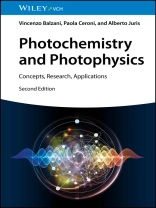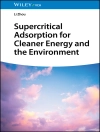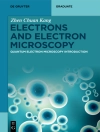Connects principles, processes, and experimental techniques with current research in the continuously expanding field of photochemistry and photophysics
Photochemistry and Photophysics covers a wide spectrum of concepts in photochemistry and photophysics, introducing principles, processes, and experimental techniques, with a wealth of examples of current applications and research spanning natural photosynthesis, photomedicine, photochromism, luminescent sensors, energy conversion and storage, and sustainability issues.
In this Second Edition, several chapters have been revised considerably and others have been almost entirely rewritten. A number of schemes and figures have been added, and the reference list at the end of each chapter has been extended and updated.
Clearly structured, the first part of the text discusses the formation, properties, and reactivity of excited states of inorganic and organic molecules and supramolecular species, and the second part focuses on photochemical and photophysical processes in natural and artificial systems. Readers will learn how photochemical and photophysical processes can be exploited for novel, unusual, and unexpected applications.
Written by world-renowned experts in the field, Photochemistry and Photophysics includes information on:
- Formation, electronic structure, properties, chemical reactivity, and radiative and nonradiative decay of electronically excited states
- Fundamental concepts and theoretical approaches concerning energy transfer and electron transfer
- Peculiar light absorption/emission spectra and the photochemical properties of the various families of organic molecules and metal complexes
- Equipment, techniques, procedures, and reference data concerning photochemical and photophysical experiments, including warnings to avoid mistakes and misinterpretations
- Relationships between photochemical, photophysical, and electrochemical properties of molecules that enable interconversion between light and chemical energy
With an appropriate mix of introductory, intermediate, and advanced content, this is an ideal textbook resource for related undergraduate and postgraduate courses. The text is also valuable for scientists already active in photochemical and photophysical research who will find helpful suggestions to undertake novel scientific projects.
Spis treści
From the Preface to the First Edition xvii
Preface to the Second Edition xix
Acknowledgments xxv
List of Abbreviations xxvii
1 Introduction 1
1.1 Photochemistry and Photophysics in Science and Technology 1
1.2 Historical Notes 2
1.3 A New Dimension of Chemistry and Physics 3
1.4 The Nature of Light 5
1.5 Absorption of Light 7
1.6 Quantum Yield, Efficiencies, and Excited-State Reactivity 8
References 10
2 Elementary Molecular Orbital Theory 11
2.1 Introduction 11
2.2 The Hydrogen Atom 11
2.3 Polyelectronic Atoms 13
2.4 From Atoms to Molecules 18
2.5 Electronic Structure of Homonuclear Diatomic Molecules 22
2.6 Electronic Structure of Heteronuclear Diatomic Molecules 26
2.7 Simple Polyatomic Molecules and Elements of Group Theory 27
2.7.1 Elements of Group Theory 27
2.7.2 Water 31
2.7.3 Ammonia 32
2.8 Typical Organic Molecules 34
2.8.1 Methane 34
2.8.2 Ethene 35
2.8.3 Benzene 38
2.8.4 Formaldehyde 40
2.9 Transition Metal Complexes 42
2.9.1 General Concepts 42
2.9.2 Typical Metal Complexes 49
References 53
3 Light Absorption and Excited-State Deactivation 55
3.1 Light Absorption 55
3.1.1 Selection Rules 57
3.1.2 Symmetry Selection Rules 57
3.1.3 Spin Selection Rules 59
3.1.4 The Franck–Condon Principle 59
3.1.5 Visualization of Photochemical Reactions on Potential Energy Surfaces 62
3.2 Jablonski Diagram 64
3.3 Excited-State Deactivation 67
3.3.1 Vibrational Relaxation 67
3.3.2 Radiationless Deactivation 67
3.3.3 Radiative Deactivation 73
3.3.4 Radiative Lifetime 74
3.4 Chemical Reactions 75
3.5 Kinetic Aspects 75
3.6 Solvent and Temperature Effects 77
3.6.1 Solvatochromic Shift 77
3.6.2 Crossing of States 81
3.6.3 Temperature Effects on Excited-State Lifetime 81
3.6.4 Thermally Activated Delayed Fluorescence 82
3.7 Selected Species 83
3.8 Semiconductors 99
References 103
4 Excited States: Physical and Chemical Properties 109
4.1 Excited State as a New Molecule 109
4.2 Lifetime 109
4.3 Energy 110
4.4 Geometry 111
4.4.1 Small Molecules 112
4.4.2 Ethene 114
4.4.3 Ethyne 114
4.4.4 Benzene 115
4.4.5 Formaldehyde 116
4.4.6 Square Planar Metal Complexes 116
4.5 Dipole Moments 117
4.6 Electron Transfer 119
4.7 Proton Transfer 122
4.8 Excimers and Exciplexes 125
References 127
5 From Molecules to Supramolecular Systems 129
5.1 Supramolecular (Multicomponent) Systems and Large Molecules 129
5.2 Electronic Interaction in Mixed-Valence Compounds 131
5.3 Electronic Interaction in Donor–Acceptor Complexes 133
5.4 Electronic Stimulation and Electronic Interaction in the Excited State 135
5.5 Excimers and Exciplexes Formation in Supramolecular Systems 138
References 140
6 Quenching and Sensitization Processes in Molecular and Supramolecular Species 143
6.1 Introduction 143
6.2 Bimolecular Quenching 144
6.2.1 Stern–Volmer Equation 144
6.2.2 Kinetic Details 146
6.2.3 Static vs Dynamic Quenching 147
6.2.4 Sensitized Emission Quantum Yield 148
6.2.5 Spin Considerations 149
6.3 Quenching and Sensitization Processes in Supramolecular Systems 150
6.4 Electron-Transfer Kinetics 153
6.4.1 Marcus Theory 154
6.4.2 Quantum Mechanical Theory 157
6.4.2.1 The Electronic Factor 158
6.4.2.2 The Nuclear Factor 160
6.4.2.3 Optical Electron Transfer 160
6.5 Energy Transfer 161
6.5.1 Coulombic Mechanism 163
6.5.2 Exchange Mechanism 165
6.6 Role of the Bridge 166
6.7 Catalyzed Deactivation 168
References 168
7 Molecular Organic Photochemistry 173
7.1 Introduction 173
7.2 Alkenes and Related Compounds 173
7.2.1 Basic Concepts 173
7.2.2 Photoisomerization of Double Bonds 174
7.2.3 Electrocyclic Processes 176
7.2.4 Sigmatropic Rearrangements 177
7.2.5 Di-π-Methane Reaction 178
7.2.6 Photocycloaddition Reactions 178
7.2.7 Photoinduced Nucleophile, Proton, and Electron Addition 179
7.3 Aromatic Compounds 180
7.3.1 Introduction 180
7.3.2 Photosubstitution 180
7.3.3 Photorearrangement 182
7.3.4 Phototransposition 182
7.3.5 Photocycloadditions 182
7.4 Carbonyl Compounds 186
7.4.1 Introduction 186
7.4.2 Photochemical Primary Processes 187
7.5 Photochemistry of Other Organic Compounds 188
7.5.1 Nitrogen Compounds 188
7.5.1.1 Overview 188
7.5.1.2 Photoisomerization of Azocompounds 189
7.5.2 Saturated Oxygen and Sulfur Compounds 189
7.5.3 Halogen Compounds 190
References 194
8 Photochemistry and Photophysics of Metal Complexes 197
8.1 Metal Complexes 197
8.2 Photophysical Properties: General Concepts 197
8.3 Photochemical Reactivity: General Concepts 198
8.4 Relationships Between Electrochemistry and Excited-State Properties 200
8.4.1 Cobalt Complexes 200
8.4.2 Copper Complexes 201
8.4.3 Ruthenium Polypyridine Complexes 202
8.4.4 Excited-State Redox Potentials 204
8.5 Luminescent Metal Complexes 206
8.5.1 Ruthenium Complexes 207
8.5.2 Rhodium Complexes 208
8.5.3 Iridium Complexes 210
8.5.4 Platinum Complexes 212
8.5.5 Chromium Complexes 217
8.5.6 Iron Complexes 222
8.5.7 Copper Complexes 226
8.5.8 Lanthanoid Complexes 228
8.5.9 Porphyrin Complexes 231
8.6 Photochemical Processes 235
8.6.1 Types of Photoreactions 235
8.6.1.1 Photodissociation and Related Reactions 235
8.6.1.2 Photooxidation–Reduction Reactions 236
8.6.1.3 Intramolecular Rearrangements 236
References 237
9 Experimental Techniques 245
9.1 Apparatus 245
9.1.1 Light Sources 245
9.1.2 Monochromators, Filters, and Solvents 252
9.1.3 Cells and Irradiation Equipment 254
9.1.4 Detectors 256
9.2 Steady-State Absorption and Emission Spectroscopy 258
9.2.1 Absorption Spectroscopy 258
9.2.1.1 Instrumentation 259
9.2.1.2 Qualitative and Quantitative Applications 260
9.2.1.3 Sample Measurement 260
9.2.2 Emission Spectroscopy 261
9.2.2.1 Instrumentation 261
9.2.2.2 Emission Spectra 263
9.2.2.3 Excitation Spectra 263
9.2.2.4 Presence of Spurious Bands 264
9.2.2.5 Quantitative Relationship Between Luminescence Intensity and Concentration 266
9.2.2.6 Stern–Volmer Luminescence Quenching 267
9.2.2.7 Emission Quantum Yields 268
9.3 Time-Resolved Absorption and Emission Spectroscopy 271
9.3.1 Transient Absorption Spectroscopy 271
9.3.1.1 Transient Absorption with Nanosecond Resolution 271
9.3.1.2 Transient Absorption with Femtosecond Resolution 273
9.3.2 Emission Lifetime Measurements 274
9.3.2.1 Single Flash 274
9.3.2.2 Gated Sampling 275
9.3.2.3 Upconversion Techniques 276
9.3.2.4 Single-Photon Counting 276
9.3.2.5 Data Analysis 278
9.3.2.6 Phase Shift 279
9.3.2.7 Luminescence Lifetime Standards 281
9.4 Absorption and Emission Measurements with Polarized Light 281
9.4.1 Linear Dichroism 281
9.4.2 Luminescence Anisotropy 283
9.4.3 Circular Dichroism 284
9.4.4 Circularly Polarized Luminescence 285
9.5 Reaction Quantum Yields and Actinometry 287
9.5.1 Reaction Quantum Yields 287
9.5.2 Actinometry 288
9.5.2.1 Potassium Ferrioxalate 289
9.5.2.2 Potassium Reineckate 290
9.5.2.3 Azobenzene 291
9.6 Other Techniques 292
9.6.1 Photothermal Methods 292
9.6.1.1 Photoacoustic Spectroscopy 292
9.6.1.2 Photorefractive Spectroscopy 293
9.6.2 Single-Molecule Spectroscopy 294
9.6.3 Fluorescence Correlation Spectroscopy 296
9.6.4 X-ray Techniques 297
References 299
10 Interconversion of Light and Chemical Energy by Bimolecular Redox Processes 305
10.1 Light as a Reactant 305
10.2 Light as a Product 306
10.3 Conversion of Light into Chemical Energy 307
10.4 Conversion of Chemical Energy into Light: Chemiluminescence 309
10.5 Conversion of Chemical Energy into Light: Electrochemiluminescence 309
10.6 Light Absorption Sensitizers 310
10.7 Light Emission Sensitizers 312
10.8 Oscillating Chemiluminescence 314
References 315
11 Photocatalysis 317
11.1 Photocatalytic Processes 317
11.2 Photocatalysis in Organic Synthesis 319
11.2.1 Photoredox Catalysis 321
11.2.1.1 Reductive Dehalogenation Catalyzed by Visible Light 322
11.2.1.2 Merging Photocatalytic and Organocatalytic Cycles 322
11.2.2 Two-Photon-Driven Photoredox Catalysis 322
11.2.3 Direct Photocatalyzed Hydrogen Transfer 327
11.3 Heterogeneous Photocatalysis 330
11.4 Photocatalysis in Environmental Protection 331
11.4.1 Principles 331
11.4.2 Solar Disinfection (SODIS) 331
11.4.3 Photo-assisted Fenton Reaction 332
11.4.4 Photocatalytic Pollution Remediation 332
References 333
12 Light-Powered Molecular Devices and Machines 339
12.1 Introduction 339
12.2 The Role of Light 340
12.3 Molecular Devices for Information Processing 342
12.3.1 Photochromic Systems as Molecular Memories 342
12.3.2 Molecular Logics 343
12.3.2.1 Luminescent Sensors as Simple Logic Gates 343
12.3.2.2 AND Logic Gate 344
12.3.2.3 Encoding and Decoding 344
12.4 Molecular Devices Based on Energy Transfer 346
12.4.1 Wires 346
12.4.2 Switches 348
12.4.3 Plug/Socket Systems 349
12.4.4 Light-Harvesting Antennas 350
12.5 Molecular Devices Based on Electron Transfer 354
12.5.1 Wires 354
12.5.2 Switches 360
12.5.3 Extension Cables 362
12.6 Light-Powered Molecular Machines 363
12.6.1 Basic Remarks 363
12.6.2 Rotary Motors Based on cis–trans Photoisomerization 365
12.6.3 Photochemically Driven Threading/Dethreading Movements 367
12.6.4 Molecular Pumps 372
12.6.5 Molecular Shuttles and Related Systems 373
12.6.5.1 An Artificial, Autonomous, Solar Light-Powered Molecular Motor 373
12.6.5.2 Three-Station Rotaxanes 376
12.6.5.3 Rotaxanes as Carriers 377
12.6.6 Molecular Walkers 377
12.6.7 Unidirectional Rotation in Catenanes 380
12.6.8 Photocontrolled Valves, Boxes, and Related Systems 383
References 385
13 Natural and Artificial Photosynthesis 395
13.1 Energy for Spaceship Earth 395
13.2 Natural Photosynthesis 397
13.2.1 Light Harvesting: Absorption and Energy Transfer 398
13.2.2 Photoinduced Electron Transfer Leading to Charge Separation 398
13.2.2.1 Bacterial Photosynthesis 398
13.2.2.2 Green Plants Photosynthesis 400
13.2.3 Efficiency of Photosynthesis 402
13.3 Artificial Photosynthesis 404
13.3.1 Water Splitting by Photocatalytic Semiconductor Nanoparticles 408
13.3.2 Water Splitting in Photoelectrochemical Cells 411
References 415
14 Photochemistry and Photophysics in Biologically Relevant Processes 421
14.1 Introduction 421
14.2 Vision 421
14.2.1 Basic Principle 421
14.2.2 Primary Photochemical Events 423
14.3 Light, Skin, and Sunscreens 423
14.4 Photochemical Damage in Living Systems 424
14.4.1 Photochemical Damage to DNA 424
14.4.2 Photochemical Damage to Proteins 425
14.5 Therapeutic Strategies Using Light 426
14.5.1 Phototherapy 426
14.5.2 Photodynamic Therapy 426
14.5.3 Photoactivated Chemotherapy 428
14.6 DNA Photocleavage and Charge Transport 432
14.6.1 Photocleaving Agents of Nucleic Acid 432
14.6.2 Photoinduced Electron-Transfer Processes in DNA 433
14.7 Fluorescence 433
14.8 Luminescent Sensors 434
14.8.1 Principles 434
14.8.2 Amplifying Signal 435
14.8.3 Oxygen Sensing and Bioimaging 436
14.8.4 Voltage Neuron Sensor 437
14.8.5 Measuring Blood Analytes 439
14.9 Bioluminescence 440
References 442
15 Technological Applications of Photochemistry and Photophysics 447
15.1 Introduction 447
15.2 Photochromism 447
15.3 Luminescent Sensors 450
15.3.1 Wind Tunnel Research 450
15.3.2 Thermometers 451
15.3.3 Detecting Warfare Chemical Agents 453
15.3.4 Detecting Explosives 455
15.4 Optical Brightening Agents 457
15.5 Atmospheric Photochemistry 457
15.5.1 Natural Processes Involving Oxygen 457
15.5.2 Ozone Hole 458
15.6 Solar Cells 459
15.6.1 Inorganic Photovoltaic (PV) Cells 459
15.6.2 Organic Solar Cells (OSCs) 462
15.6.3 Dye-Sensitized Solar Cells (DSSCs) 463
15.7 Electroluminescent Materials 465
15.7.1 Light-Emitting Diodes (LEDs) 465
15.7.2 Organic Light-Emitting Diodes (OLEDs) 466
15.7.3 Light-Emitting Electrochemical Cells (LECs) 467
15.8 Polymers and Light 469
15.8.1 Photopolymerization 469
15.8.2 Photodegradation 470
15.8.3 Stabilization of Commercial Polymers 470
15.8.4 Photochemical Curing 471
15.8.5 Other Light-Induced Processes 471
15.8.6 Photolithography 472
15.8.7 Stereolithography 473
15.8.8 Holography 474
15.9 Light for Chemical Synthesis 475
15.9.1 Photochlorination of Polymers 476
15.9.2 Synthesis of Caprolactam 476
15.9.3 Synthesis of Vitamins 476
15.9.4 Perfumes 477
References 478
16 Research Frontiers 485
16.1 Introduction 485
16.2 Luminescent First-Row Transition Metal Complexes 485
16.2.1 Luminescent Cr(III) and V(III) Complexes 485
16.2.2 Luminescent Cu(I) Complexes 486
16.3 Aggregation-Induced Emission 489
16.4 TADF Chromophores 494
16.5 Photoactivated Molecular Machine 495
16.6 Photoactivated Molecular Tweezer in a Multifunctional Compound 498
16.7 Singlet Fission 499
16.8 Chirality-Induced Spin Selectivity in Electron Donor–Acceptor Dyads 503
16.9 Photocatalytic Water Splitting 504
References 506
Index 511
O autorze
Vincenzo Balzani is Emeritus Professor of Chemistry at the University of Bologna, Italy. His scientific activity is documented by eight books and ~650 scientific papers in the fields of photochemistry, supramolecular chemistry, molecular machines, and solar energy conversion.
Paola Ceroni is Professor at the University of Bologna. She has published ~250 scientific papers.
Alberto Juris is former Associate Professor of General and Inorganic Chemistry at the University of Bologna.












